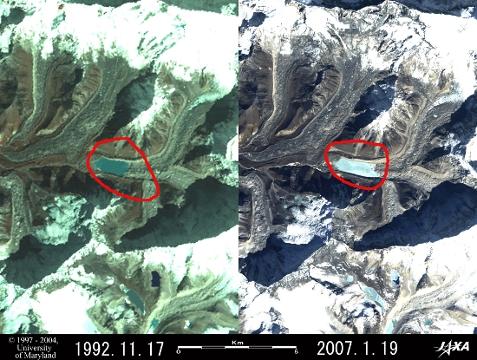

|
Glaciers Monitoring and Early Warning System Remote Sensing Perspective |
|
This web page is design as a part of academic project work for the course GPH 909 ( Fall,2010). Compiled information in this page portrays basic skills of a student in presenting the application of remote sensing in Glacier monitoring and early warning system by providing available web resources( locating). Further, to facilitate the viewers this site also features information of Glaciers, Glaciers Lake ,Glacier Lake Outburst Floods (GLOFs), basic science of Remote Sensing, satellite images, case study, and hyperlinks as far as possible.
Glaciers interact sensitively with climate and therefore they are climate indicators (Oerlemans, 1994). The international program Global Land Ice Measurements from Space (GLIMS) monitors extent, changes, and dynamics of glaciers worldwide using satellite data, particularly from the ASTER sensor (Bishop et al., 2004; Kargel et al., 2005). Much work has been done to analyze glaciers and glacier changes using remote sensing techniques (Bishop et al., 2000; Della Ventura et al., 1987).
Over the centuries, glaciers have been responsible for many natural disasters as a result of ice avalanches. Other disasters have arisen from the damming of lakes by glaciers and moraines, followed by failure of the dam. The worst disasters, accounting for tens of thousands of lives, have occurred in Peru, but other seriously affected regions have been the Himalaya and the Alps.
|

|
Figure1 : Image showing Tsho Rolpa glaicders lake (Nepal) over different year (courtesy: JAXA,2007) |

|
Figure2 :Satellite image of Huaraz (H) and its relationship with the nearby Cordillera Blanca, Peru. An outburst flood from Laguna Cohup (P) on 13 December 1947 killed 7000 people. Dangers were reduced later by lowering of the moraine-dammed lake Llaca (L) in the adjacent valley (NASA image 5 November 2001). |
|
Design by: Milan Budhathoki, MS Geo-Information Science, Salem State University, Salem, MA m_budhathoki@salemstate.edu Last updated on 22nd November,2010 |
|
Introduction |